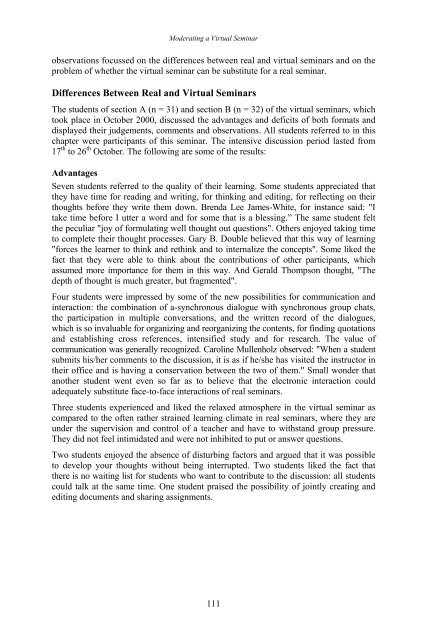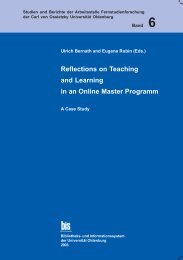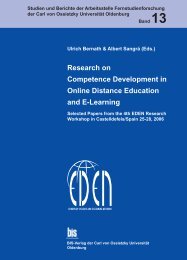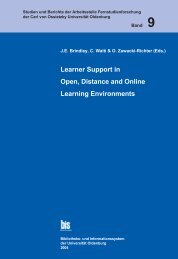Distance Education in Transition - Master of Distance Education ...
Distance Education in Transition - Master of Distance Education ...
Distance Education in Transition - Master of Distance Education ...
You also want an ePaper? Increase the reach of your titles
YUMPU automatically turns print PDFs into web optimized ePapers that Google loves.
Moderat<strong>in</strong>g a Virtual Sem<strong>in</strong>ar<br />
observations focussed on the differences between real and virtual sem<strong>in</strong>ars and on the<br />
problem <strong>of</strong> whether the virtual sem<strong>in</strong>ar can be substitute for a real sem<strong>in</strong>ar.<br />
Differences Between Real and Virtual Sem<strong>in</strong>ars<br />
The students <strong>of</strong> section A (n = 31) and section B (n = 32) <strong>of</strong> the virtual sem<strong>in</strong>ars, which<br />
took place <strong>in</strong> October 2000, discussed the advantages and deficits <strong>of</strong> both formats and<br />
displayed their judgements, comments and observations. All students referred to <strong>in</strong> this<br />
chapter were participants <strong>of</strong> this sem<strong>in</strong>ar. The <strong>in</strong>tensive discussion period lasted from<br />
17 th to 26 th October. The follow<strong>in</strong>g are some <strong>of</strong> the results:<br />
Advantages<br />
Seven students referred to the quality <strong>of</strong> their learn<strong>in</strong>g. Some students appreciated that<br />
they have time for read<strong>in</strong>g and writ<strong>in</strong>g, for th<strong>in</strong>k<strong>in</strong>g and edit<strong>in</strong>g, for reflect<strong>in</strong>g on their<br />
thoughts before they write them down. Brenda Lee James-White, for <strong>in</strong>stance said: "I<br />
take time before I utter a word and for some that is a bless<strong>in</strong>g.” The same student felt<br />
the peculiar "joy <strong>of</strong> formulat<strong>in</strong>g well thought out questions". Others enjoyed tak<strong>in</strong>g time<br />
to complete their thought processes. Gary B. Double believed that this way <strong>of</strong> learn<strong>in</strong>g<br />
"forces the learner to th<strong>in</strong>k and reth<strong>in</strong>k and to <strong>in</strong>ternalize the concepts". Some liked the<br />
fact that they were able to th<strong>in</strong>k about the contributions <strong>of</strong> other participants, which<br />
assumed more importance for them <strong>in</strong> this way. And Gerald Thompson thought, "The<br />
depth <strong>of</strong> thought is much greater, but fragmented".<br />
Four students were impressed by some <strong>of</strong> the new possibilities for communication and<br />
<strong>in</strong>teraction: the comb<strong>in</strong>ation <strong>of</strong> a-synchronous dialogue with synchronous group chats,<br />
the participation <strong>in</strong> multiple conversations, and the written record <strong>of</strong> the dialogues,<br />
which is so <strong>in</strong>valuable for organiz<strong>in</strong>g and reorganiz<strong>in</strong>g the contents, for f<strong>in</strong>d<strong>in</strong>g quotations<br />
and establish<strong>in</strong>g cross references, <strong>in</strong>tensified study and for research. The value <strong>of</strong><br />
communication was generally recognized. Carol<strong>in</strong>e Mullenholz observed: "When a student<br />
submits his/her comments to the discussion, it is as if he/she has visited the <strong>in</strong>structor <strong>in</strong><br />
their <strong>of</strong>fice and is hav<strong>in</strong>g a conservation between the two <strong>of</strong> them." Small wonder that<br />
another student went even so far as to believe that the electronic <strong>in</strong>teraction could<br />
adequately substitute face-to-face <strong>in</strong>teractions <strong>of</strong> real sem<strong>in</strong>ars.<br />
Three students experienced and liked the relaxed atmosphere <strong>in</strong> the virtual sem<strong>in</strong>ar as<br />
compared to the <strong>of</strong>ten rather stra<strong>in</strong>ed learn<strong>in</strong>g climate <strong>in</strong> real sem<strong>in</strong>ars, where they are<br />
under the supervision and control <strong>of</strong> a teacher and have to withstand group pressure.<br />
They did not feel <strong>in</strong>timidated and were not <strong>in</strong>hibited to put or answer questions.<br />
Two students enjoyed the absence <strong>of</strong> disturb<strong>in</strong>g factors and argued that it was possible<br />
to develop your thoughts without be<strong>in</strong>g <strong>in</strong>terrupted. Two students liked the fact that<br />
there is no wait<strong>in</strong>g list for students who want to contribute to the discussion: all students<br />
could talk at the same time. One student praised the possibility <strong>of</strong> jo<strong>in</strong>tly creat<strong>in</strong>g and<br />
edit<strong>in</strong>g documents and shar<strong>in</strong>g assignments.<br />
111





